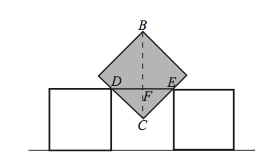Difference between revisions of "2005 AMC 10A Problems/Problem 19"
(→Solution) |
(→See Also) |
||
| Line 31: | Line 31: | ||
==See Also== | ==See Also== | ||
| − | {{AMC10 box|year=2005|ab=A|num-b= | + | {{AMC10 box|year=2005|ab=A|num-b=18|num-a=20}} |
[[Category:Introductory Geometry Problems]] | [[Category:Introductory Geometry Problems]] | ||
[[Category:Area Ratio Problems]] | [[Category:Area Ratio Problems]] | ||
{{MAA Notice}} | {{MAA Notice}} | ||
Revision as of 11:53, 26 November 2015
Problem
Three one-inch squares are placed with their bases on a line. The center square is lifted out and rotated 45 degrees, as shown. Then it is centered and lowered into its original location until it touches both of the adjoining squares. How many inches is the point ![]() from the line on which the bases of the original squares were placed?
from the line on which the bases of the original squares were placed?
![[asy] unitsize(1inch); defaultpen(linewidth(.8pt)+fontsize(8pt)); draw((0,0)--((1/3) + 3*(1/2),0)); fill(((1/6) + (1/2),0)--((1/6) + (1/2),(1/2))--((1/6) + 1,(1/2))--((1/6) + 1,0)--cycle, rgb(.7,.7,.7)); draw(((1/6),0)--((1/6) + (1/2),0)--((1/6) + (1/2),(1/2))--((1/6),(1/2))--cycle); draw(((1/6) + (1/2),0)--((1/6) + (1/2),(1/2))--((1/6) + 1,(1/2))--((1/6) + 1,0)--cycle); draw(((1/6) + 1,0)--((1/6) + 1,(1/2))--((1/6) + (3/2),(1/2))--((1/6) + (3/2),0)--cycle); draw((2,0)--(2 + (1/3) + (3/2),0)); draw(((2/3) + (3/2),0)--((2/3) + 2,0)--((2/3) + 2,(1/2))--((2/3) + (3/2),(1/2))--cycle); draw(((2/3) + (5/2),0)--((2/3) + (5/2),(1/2))--((2/3) + 3,(1/2))--((2/3) + 3,0)--cycle); label("$B$",((1/6) + (1/2),(1/2)),NW); label("$B$",((2/3) + 2 + (1/4),(29/30)),NNE); draw(((1/6) + (1/2),(1/2)+0.05)..(1,.8)..((2/3) + 2 + (1/4)-.05,(29/30)),EndArrow(HookHead,3)); fill(((2/3) + 2 + (1/4),(1/4))--((2/3) + (5/2) + (1/10),(1/2) + (1/9))--((2/3) + 2 + (1/4),(29/30))--((2/3) + 2 - (1/10),(1/2) + (1/9))--cycle, rgb(.7,.7,.7)); draw(((2/3) + 2 + (1/4),(1/4))--((2/3) + (5/2) + (1/10),(1/2) + (1/9))--((2/3) + 2 + (1/4),(29/30))--((2/3) + 2 - (1/10),(1/2) + (1/9))--cycle);[/asy]](http://latex.artofproblemsolving.com/a/7/c/a7cc2885a1128684338473a8a960bdd8b0ed372f.png)
![]()
Solution
Consider the rotated middle square shown in the figure. It will drop until length ![]() is 1 inch. Then, because
is 1 inch. Then, because ![]() is a
is a ![]() triangle,
triangle, ![]() , and
, and ![]() . We know that
. We know that ![]() , so the distance from
, so the distance from ![]() to the line is
to the line is
![]()
![]() .
.
See Also
| 2005 AMC 10A (Problems • Answer Key • Resources) | ||
| Preceded by Problem 18 |
Followed by Problem 20 | |
| 1 • 2 • 3 • 4 • 5 • 6 • 7 • 8 • 9 • 10 • 11 • 12 • 13 • 14 • 15 • 16 • 17 • 18 • 19 • 20 • 21 • 22 • 23 • 24 • 25 | ||
| All AMC 10 Problems and Solutions | ||
The problems on this page are copyrighted by the Mathematical Association of America's American Mathematics Competitions. ![]()










